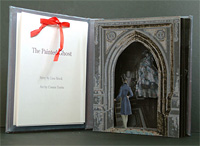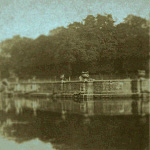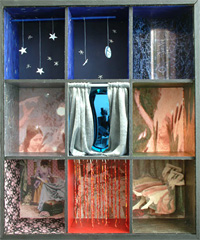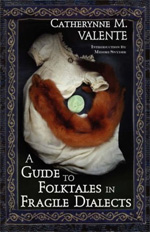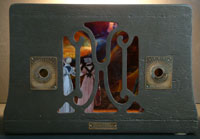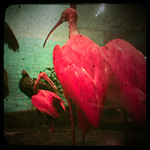Moved Permanently
The document has moved here.
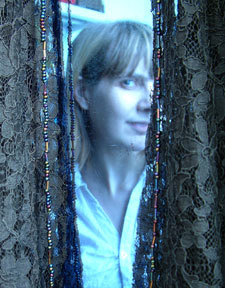
With artwork that has been described by Endicott Redux as "gorgeous", it is easy to understand why Connie Toebe's work was selected to grace the cover of Interfictions, the first collection of stories compiled by the Interstitial Arts Foundation and published by Small Beer Press in 2007. Not only is her work strikingly beautiful, but upon closer examination it becomes obvious why Connie's art was a perfect fit for the IAF: combining elements of photography, collage, assemblage, and sometimes even Flash animation, Connie Toebe is the very definition of an interstitial artist, defying categorization.
Influences and Inspiration
From her photographs taken with very old cameras or her experiments with pinhole photography, her entrancing Flash animated online series Through the Cobweb Forest (created with writer and filmmaker Lisa Stock), to her intriguing diorama boxes, it is hard to believe that Connie Toebe began life in what she calls "a very plain Jane, Midwestern, middle class upbringing." The last of five children, Connie grew up just outside of St. Louis in Florissant, Missouri. Noting that her childhood predated video games and computers, Connie says, "There wasn't always money for fancy toys so we had to use our imagination." While in the Girl Scouts, Connie and the other children were given arts and crafts projects to work on, but even on her own Connie was constantly creating, whether making blueprints for her dream house or writing a magazine about horses. Connie's love of art was a constant throughout her childhood and growing up. Connie notes that she cannot point to just one crystallized moment in which she chose to pursue art: "I can't say I ever had an 'a-ha' moment. I've always loved doing art and creating things," she explains, "just fun stuff that I did in my room." Both the act of creating art and the world of storytelling became the fertile ground that fed Connie's youthful imagination.
From an early age, books were a huge influence on Connie. "My earliest memories of books are of my dad bringing me home books from the library," she says. "I like the odd folk tale and Magical Realist fiction has a wonderful visual element to it." While the visual has always played a big role in the formation of her tastes, Connie notes that she cannot cite only one artist as having been a particular favorite as a child. In high school she was drawn to the work of the Surrealists, and at the School of the Art Institute of Chicago (where she graduated with a BFA) Connie was eager to explore a variety of techniques: "I took anything and everything that struck my fancy (which shows in my art now I think)," she explains. "I was creating art immediately after graduation, first photography, then painting, then the diorama boxes. Currently I'm mostly doing photography." Connie also looks constantly to art, whether in books, museums or something she sees on television, for inspiration. "I'm always looking, looking, looking," Connie enthuses. "You just never know what you're going to see. More and more, I think the big city is inspiring me. It's not always easy to see the magic in buildings and concrete but if you pay attention, it's definitely there."
An Interstitial Artist Covers Books and CDs in a Cobweb Forest
Between 2005 and 2006 came one of Connie's first commissions, the design and artwork for a CD called Ink by the avant garde group Zelienople. Although she knew the band members very well, Connie did not expect that they would seek her out for her talents behind the camera: "I was surprised about the Zelienople cover," she explains, "as one of the guys in the band is a photographer, and as far as I know, has done all the other album covers." While the process did not take terribly long to produce, the effect was created by manipulating three very old photographs.
Connie first encountered the notion of interstitiality around this same period (2005-2006) at Wiscon, the world's leading feminist science fiction/fantasy conference in Madison, Wisconsin. Connie remembers hearing Ellen Kushner discuss interstitiality at a panel, in which Ellen mentioned an artist trying to describe a piece of art as "a bit of this and sorta like that." It was a moment of clarity for Connie, who says, "My diorama boxes have always been difficult to describe and market so this was exactly the dilemma I was going through. I knew then that I'd fit right in." Connie eventually became a member of the IAF's Working Group, and when a contest came along for Interfictions' cover art Connie sent in her submission. Happily, Connie's art was chosen, an achievement which she calls "a big highlight". The book was released in spring of 2007, and its cover art was nominated for the BSFA (British Sci-Fi Association) award for best art.
2007 also saw the completion of Through the Cobweb Forest, an online Flash animation created with writer and filmmaker Lisa Stock. "It took almost two years from first coming up with the idea to posting the last chapter," Connie recalls. "I had to teach myself Flash in order to do it so that was quite a feat." The following year in 2008 Connie created cover artwork for Catherynne Valente's A Guide to Folktales in Fragile Dialects, which featured a foreword by Midori Snyder. 2008 was also the year Wiscon awarded Connie Best 3-D Art, which took her by surprise. She comments, "I've never really sought out awards though, and I've rarely shown in the type of art shows that give awards." In 2009 Connie returned to creating CD cover art using pinhole photography for artist Neil Jendon's album Invisibility. Connie also made a music video for Jendon from one of his live shows, which can be viewed here. This October 16-18, 2009 Connie exhibited her work at art fair in Chicago called Around the Coyote. Connie was excited about participating in the show, adding, "I haven't tried out for any art shows in several years so this was a nice way to get back into things."
Tools and Techniques
Connie uses a variety of media with which she chooses to express herself. Perhaps best known for her diorama boxes (similar to what can be seen on the cover of Interfictions), Connie is very resourceful in her reinvention of recycled objects, noting that she likes to "use a bit of everything. I like to use found boxes. I've used old radio and speaker cabinets, cigar boxes, even an old cardboard game box. Right now I have a big old wooden TV cabinet from the 50's that I found in the alleyway behind my house. I'll be making that into a diorama with some 'honeycombs' that we cleaned out from wasp nests below our porch. I also sometimes make my own boxes." The boxes are merely the starting point, as they literally set the stage for the tiny dramas that unfolds within. "I use a lot of Victorian imagery," Connie continues, "mostly from old ladies' fashion magazines, antique travel and science books. I LOVE old Victorian books and buy them all the time. I was given a bunch of Victorian era fabric scraps, hand crochet pieces, lace, etc. that I'm starting to work into my boxes." Victorian imagery was also featured heavily in Connie and Lisa Stock's Flash animated piece, Through the Cobweb Forest.
At the present time Connie is primarily focusing her creative attention on the art of photography. She is most excited about "alternative" processes such as TtV, or "Through the Viewfinder", which she describes as "a picture through the viewfinder of another, generally old, camera. It's a bit hard to explain but you can see some of my TtV photos on my photography website www.flowerquetzal.com." Connie is currently exploring another alternative process: "I'm also doing a lot of pinhole photography," she says. "In line with my handmade dioramas, I've been taking a lot of photos of museum dioramas as I'm really fascinated by them." By using antique cameras and methods Connie is able to capture an elusive vision of the world of the past lacking in the hard edged world of today. "I really like the sense of age those techniques give," she says. "There's just some je ne sais quoi that photos done that way have." Whether enjoying Connie's dioramas or her photography, the viewer is left with the impression of having peered into a lost, private, and magical realm captured momentarily with Connie's artistic eye.
About the Author
Chandra Peltier has written for a variety of magazines including Faerie, Art Doll Quarterly, Belle Armoire, Contemporary Doll Collector, and DOLLS. She recently finished her first novel.


